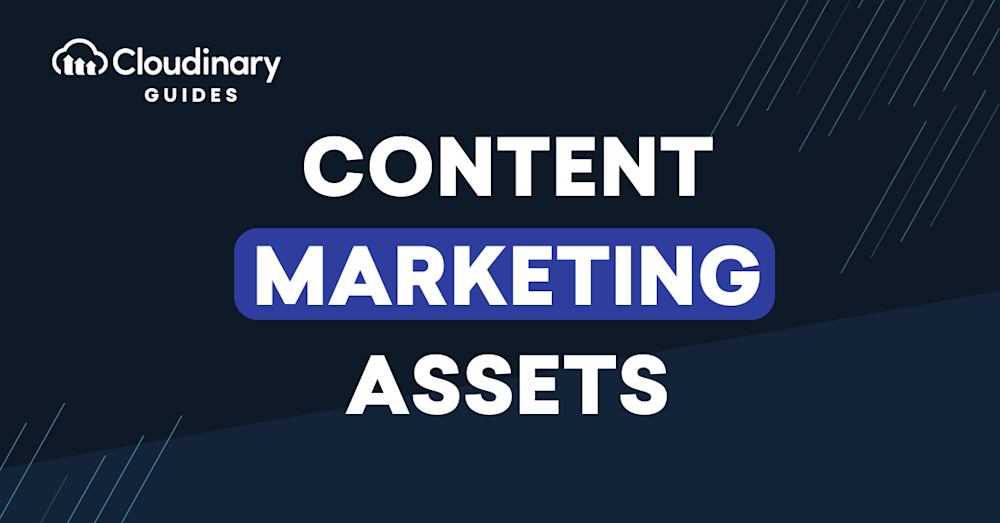Unlock the Power of Diverse Content Types to Boost Your Digital Marketing Strategy
The right assets can make all the difference in the success of your digital marketing strategy. Content marketing assets are the backbone of any online marketing campaign, helping you connect with your audience, showcase your expertise, and drive results. In fact, according to HubSpot, 70% of marketers are actively investing in content marketing.
With such a high percentage of marketers recognizing the value of content, it’s crucial to understand the various types of assets and how to leverage them effectively. In this article, we’ll explore the importance of content marketing assets and how they can elevate your digital marketing game.
In this article:
- What is a Content Asset?
- The Importance of Content Marketing Assets and Why Do You Need Them?
- Types of Content Marketing Assets
- Best Practices for Your Content Marketing Assets
- Control Your Assets with Cloudinary
What is a Content Asset?
A content asset is a valuable resource created by an organization to distribute information to its audience, fulfilling different strategic purposes such as building brand awareness, enhancing credibility, generating more qualified leads, and increasing conversions.
Content assets can be either ungated, offering free and immediate access to readers, or gated, requiring audience members to provide their contact information before access is granted. While ungated assets are ideal for attracting top-of-the-funnel (TOFU) prospects, gated assets are more effective for engaging mid-funnel (MOFU) and bottom-of-funnel (BOFU) prospects, who are likely more interested and closer to making purchasing decisions.
The Importance of Content Marketing Assets and Why Do You Need Them?
Content marketing assets are not just pieces of text or visuals scattered across the internet; they’re strategic tools designed to engage, inform, and eventually convert your audience. At their core, these assets include blogs, infographics, videos, e-books, and much more, each serving a unique purpose in the broad spectrum of digital marketing.
Think of them as equivalent to well-documented code comments or robust APIs that make software more usable and valuable. Just as well-commented code can save hours of debugging, a well-crafted piece of content can save your audience hours of search time, making your brand a go-to source for information and solutions.
Your audience’s attention is the currency, and content marketing assets are the bank. They not only help in building brand awareness by providing valuable information in an accessible format but also aid in establishing credibility and authority in your field. Imagine trying to explain a complex technical concept without visual aids or comprehensive guides; it’s doable but hardly as effective.
Content marketing assets bridge that gap, transforming abstract ideas into tangible value your audience can appreciate and understand. They play a critical role in SEO, driving organic traffic to your site and keeping you visible in the ever-competitive digital space. Whether you’re targeting end-users or fellow professionals, the right content marketing assets can significantly amplify your voice and presence online.
Pro Tip!Consider Cloudinary’s Digital Asset Management
Looking for a centralized location to manage all your media assets? Cloudinary’s Media Library makes it easy to upload, store, manage, and deliver images and videos efficiently.
Types of Content Marketing Assets
Now that we’ve established the significance of content marketing assets, it’s time to delve into the diverse types you can utilize in your digital marketing strategy. From blog posts and infographics to videos and social media content, there’s a wide array of assets to choose from, each offering unique benefits and catering to different audience preferences. Let’s take a closer look at some of the most popular kinds, and how you should use them.
Podcasts
Podcasts are a unique form of content marketing, offering a personal and engaging way to communicate with your audience. They are especially effective for storytelling, sharing insights, and discussing industry trends. To create a successful podcast:
- Identify topics that resonate with your audience and plan a series of episodes.
- Invest in quality recording equipment to ensure clear audio.
- Promote your podcasts through your website, social media channels, and podcast directories.
Reports
Reports, particularly those based on research or data analysis, can significantly boost your authority in your industry. They are ideal for sharing original insights and detailed information. To create impactful reports:
- Conduct thorough research and present your findings in a structured format.
- Use visuals and infographics to illustrate key data points.
- Share your reports through your website, email newsletters, and professional networks.
Branded Templates
Incorporating branded templates for documents, presentations, and social media posts ensures consistency in your visual branding. These templates should align with your brand’s color scheme, typography, and overall aesthetic.
Blog Posts
Blog posts are essential to content marketing assets, offering a platform to share valuable information, insights, and opinions with your target audience. By providing relevant and engaging content, blog posts attract visitors to your site and help establish your brand as an authority.
To create compelling blog posts:
- Identify topics that resonate with your audience and address their needs or pain points.
- Conduct keyword research to optimize your content for search engines and improve its visibility.
- Ensure your writing is clear, concise, and easy to understand while incorporating a compelling headline to grab your readers’ attention.
- Break up your content into smaller sections using subheadings, bullet points, and images to make it more visually appealing and easy to digest.
Infographics
Infographics are visually engaging content marketing asset that presents complex information or data in an easily digestible and appealing format. By combining elements of design, illustration, and text, infographics can effectively communicate key messages, statistics, or insights in a way that captures your audience’s attention. They are handy for simplifying complicated concepts, making comparisons, or highlighting trends and can be shared across various platforms, including websites, blogs, and social media.
To create an effective infographic:
- Start by defining a clear objective and gathering relevant data or information to support your message.
- Choose a visually appealing layout and color scheme that aligns with your brand identity while ensuring the design remains uncluttered and easy to follow.
- Use concise and straightforward language to convey your information, and break it down into smaller sections or data points to maintain a logical flow.
- Ensure that your infographic is shareable and easily embeddable, and include your logo and a call-to-action to drive engagement and brand recognition.
Videos
Videos are a powerful content marketing asset that can captivate your audience, convey complex information, and evoke emotions like no other medium. From product demonstrations and how-to tutorials to customer testimonials and behind-the-scenes footage, videos offer a dynamic and immersive way to engage with your target audience and showcase your brand’s personality. With the increasing popularity of video content on platforms like YouTube, Instagram, and Facebook, incorporating videos into your marketing strategy is essential for staying relevant and competitive.
To create compelling videos:
- Define your objectives and identify the target audience.
- Develop a persuasive storyline or script that addresses your audience’s needs or interests, and keep the video duration concise to maintain viewer attention.
- Ensure your video has high production quality, with clear visuals and audio, to create a professional and polished impression.
- Use attention-grabbing thumbnails, titles, and descriptions to entice viewers to watch your content.
- Optimize your videos for search engines by incorporating relevant keywords and tags and sharing them across your marketing channels to maximize reach and engagement.
- Don’t be afraid to experiment with different video formats and styles to find the perfect fit for your brand and audience.
eBooks and Whitepapers
eBooks and whitepapers are long-form content marketing assets designed to educate and inform your audience on specific topics. While eBooks often provide comprehensive guides or tutorials, whitepapers present a more formal analysis of a problem and its solution backed by data and expert insights. These assets are ideal for showcasing your brand’s expertise, building credibility, and generating leads.
To create compelling eBooks or whitepapers:
- Choose a topic that addresses your audience’s needs, and conduct thorough research to gather accurate information.
- Present your findings clearly, and organized, using a visually appealing layout and design.
- To enhance readability, break up the text with subheadings, bullet points, and visuals.
- Write clearly, concisely, and always cite your sources to ensure credibility.
- Promote your content through your marketing channels and consider using snippets to pique interest and drive downloads.
Social Media Content
Social media content encompasses a variety of formats, such as images, videos, text, and links, that are shared on platforms like Facebook, Instagram, Twitter, and LinkedIn. This type of content marketing asset plays a crucial role in engaging with your audience, increasing brand visibility, and driving traffic to your website. Social media content allows you to showcase your brand personality, share updates, and interact with your followers in a more casual and approachable manner.
To create effective social media content:
- Identify your target audience and their preferences for each platform.
- Craft engaging, concise, and shareable content that resonates with your followers, and use visuals like images and videos to boost engagement.
- Maintain a consistent posting schedule and vary your content types to keep your audience interested.
- Engage with your followers by responding to comments, asking questions, and encouraging user-generated content.
- Monitor your social media performance and adjust your strategy based on data-driven insights to optimize your content’s effectiveness.
Best Practices For Your Content Marketing Assets
When creating content marketing assets, it’s essential to follow best practices to ensure their effectiveness in engaging your audience and achieving your marketing goals. First and foremost, maintain consistency in branding across all your assets, including visuals, tone, and messaging, to create a cohesive brand identity and enhance recognition.
Focus on creating high-quality content that is relevant, informative, and engaging for your target audience. Optimize your media assets for search engines and various platforms to improve visibility and accessibility. Consider using the best digital asset management tools to streamline your workflows, such as scheduling social media posts, automating email campaigns, and generating content ideas, allowing you to focus on crafting compelling content while maximizing efficiency. By adhering to these best practices, you’ll be well on your way to creating a successful content marketing strategy.
Control Your Assets with Cloudinary
Content marketing assets are the backbone of any successful marketing strategy, enabling you to engage, inform, and connect with your target audience. By leveraging diverse assets, you can create a rich and immersive experience that resonates with your audience and drives results. Remember to follow best practices, such as maintaining brand consistency, producing high-quality content, optimizing your assets, and utilizing intelligent automation to streamline your workflows.
To manage your content marketing assets effectively, consider using a powerful tool like Cloudinary. With its robust features and user-friendly interface, Cloudinary simplifies asset management, allowing you to focus on creating compelling content and growing your brand. Give Cloudinary a try today and see how it can revolutionize your content marketing strategy.


